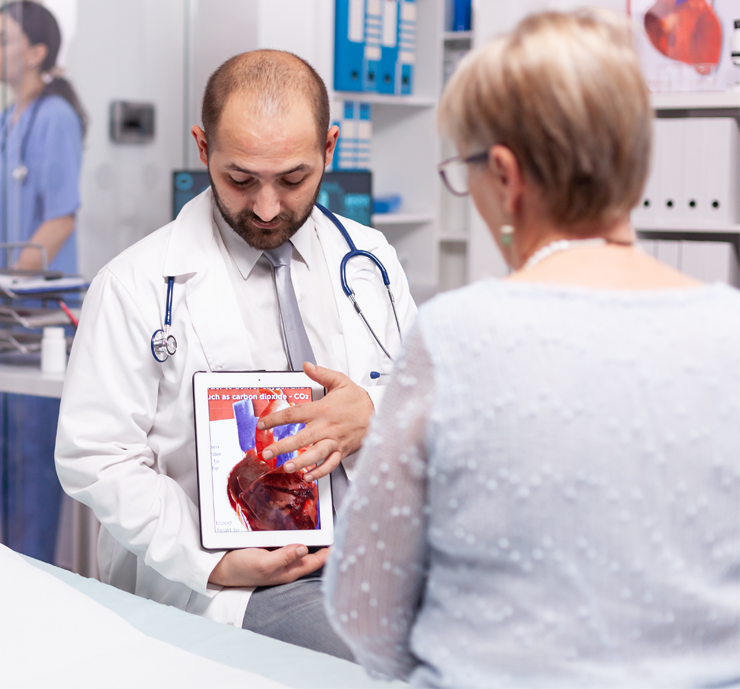Cardiac Surgery
Coronary Artery Disease
Our high-tech approach to surgical care includes state-of-the-art technology and minimally invasive techniques that provide the excellent patient care you have come to expect in addition to shortening your recovery time. Shasta Regional Medical Center surgeons perform a broad spectrum of surgeries including general, orthopedic, vascular, spine, gynecologic, thoracic, cardiac, urologic, and ear, nose, and throat.
We are pleased to offer a blood conservation option for surgical procedures as well. From the time you enter our pre-op clinic until you are discharged home, you will be under the care and guidance of our compassionate and experienced staff, most of whom have received advanced certification in their field. We look forward to meeting you and accompanying you on your journey to recovery.
For further information, contact us at 530-244-5400
What Is Coronary Artery Bypass?
This is the most common type of heart surgery. It is sometimes also called coronary artery bypass graft surgery (CABG), coronary artery bypass, coronary bypassor bypass surgery.
In this procedure, a section of vein or artery from your leg, chest or another part of your body is used to bypass the blocked or diseased portion of a coronary artery, which brings blood to the muscle of your heart. This creates a new, clear way for the blood to flow to get oxygen to your heart muscle so it can work properly. This type of surgery is done to the outer walls of the heart; it doesn’t require opening up the chambers of the heart.
You will hear folks talk about single, double, triple or quadruple bypass surgery. This refers to the number of blocked arteries that had to be bypassed. The need for more bypasses doesn’t mean the heart condition is worse.
Normally during bypass surgery, the breastbone (sternum) is divided. The heart itself is stopped and cooled. The blood that normally would be pumped by the heart is sent through a heart-lung machine.
A long piece of vein is removed from the leg. In some cases, a small vessel from the lower arm, the radial artery, may also be used for the bypass.
This is called a graft. One end will be attached to the ascending aorta, the large artery that carries oxygen-rich blood from the heart to the rest of the body. The other end of the graft will be attached to a coronary artery below the blocked area. The surgery can take two to six hours, depending on the number of bypasses needed.
Recovering After Bypass Surgery
Your length of stay in the hospital after Bypass Surgery varies, but on average you can expect to stay in the hospital for about 5-7 days. If you have an office job, you can usually go back to work in four to six weeks depending on physical demands of your job.
In some extreme cases, if your job is physically demanding you may need to wait longer or find a job that is less physically demanding.
About 20 to 30% of bypass patients need a second bypass operation within 10 years. To prevent your new arteries from becoming diseased, it’s important that you take steps to prevent your heart disease from getting worse by limiting the amount of fat and cholesterol in your diet along with maintaining a healthy weight. Quitting smoking and finding effective ways to cope with stress is also very important.
For most bypass surgeries, a heart-lung machine is used to pump blood throughout your body while the surgeon operates on your heart. In off-pump heart surgery, this machine is not used. While the surgeon works on the controlled part of the heart, the rest of the organ continues to function. The off-pump technique is used for patients who have complications that put them at risk if using the traditional heart-lung machine method of bypass surgery.
What Is a Valve Repair or Replacement
Heart valves are flaps, or leaflets, of tissue that ensure that blood entering or leaving the heart moves in the proper direction, with no backflow. The heart and its great vessels have a total of four valves, the mitral valve, tricuspid valve, aortic valve, and pulmonary valve. Valvular disease can affect any of these four valves, and can interfere with the normal flow of blood through the heart. Heart valves that are defective may either be repaired or replaced with a tissue or mechanical substitute, depending on the nature and severity of the condition.
Repair of Heart Valves
One method of heart valve treatment involves restoring the valve to normal function by removing damaged or malformed tissue and surgically reconstructing the valve. An advantage of this method is that the patient’s own valve tissues are used, so that long-term anticoagulation is not required.
Replacement of Heart Valves
Replacement is necessary when the valve is degenerated beyond repair. The old valve is removed and replaced with a new valve mechanism, which can be:
- bioprosthetic, made from animal tissue
- mechanical, typically carbon covered with cloth
- homograft, from donated human tissue
In some cases, replacement of a damaged aortic valve is accomplished by using the patient’s own pulmonary valve.
Featured Services

Behavioral Health

Emergency Services

Lab Services

Wound Care



